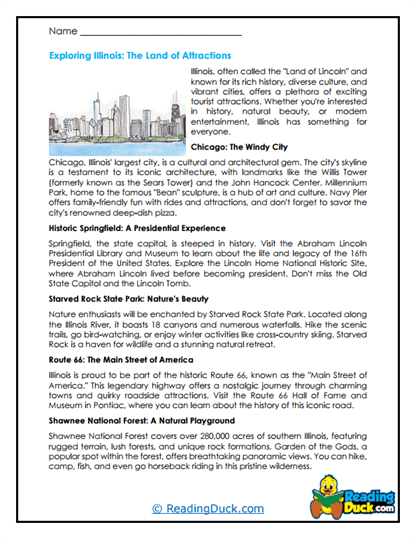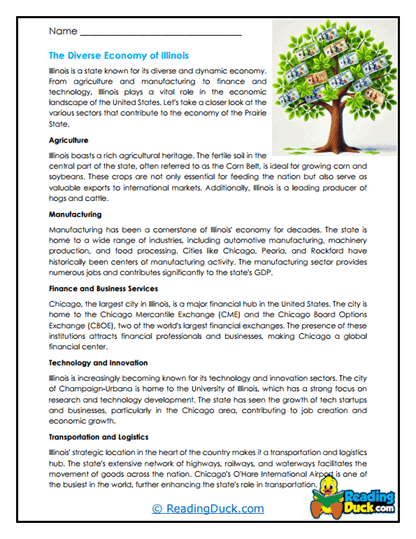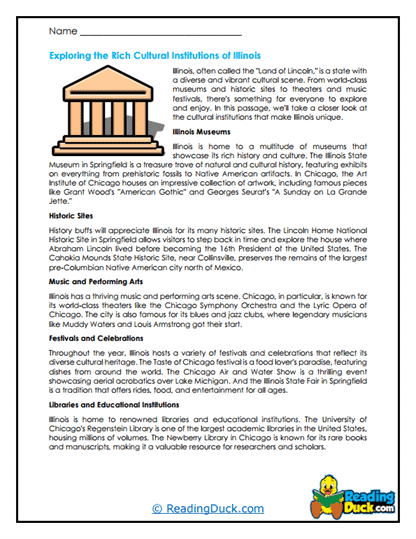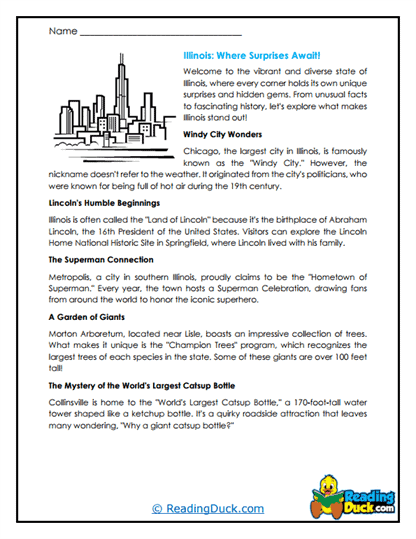Illinois Worksheets
About Our Illinois Worksheets
Our collection of Illinois worksheets provides students with an engaging and thorough exploration of the history, culture, and geography of the Prairie State. As part of the Social Studies curriculum under U.S. History, these worksheets delve into the significant events, figures, and places that have shaped Illinois. Each worksheet set is carefully designed to reinforce key concepts and encourage critical thinking through a variety of question formats and visually appealing content.
Each worksheet set includes:
- Multiple Choice Questions: These questions assess students' understanding of the reading passage by offering several answer options, helping to reinforce essential facts and concepts about Illinois’s history, geography, and culture.
- Short Answer Questions: In this section, students are encouraged to write their own answers to questions based on the reading passage. This format allows students to express their understanding in their own words, promoting deeper comprehension of the material.
- Open-Ended Questions: These questions prompt students to provide personal input, opinions, or reflections related to the reading material. This format encourages students to connect the topic of Illinois to their own experiences and broader understanding of U.S. history and geography.
An answer key is provided for all question sheets, making it easy for teachers and parents to review and assess students' work. All worksheets are available as PDF files, which can be easily viewed electronically, downloaded, and printed for use in classrooms or homeschool settings.
Illinois: The Land of Lincoln and a Crossroads of America
Illinois is a state rich in history, culture, and economic significance, making it a vital part of the story of America. When teaching students about Illinois, it's essential to cover the key events and developments that have shaped the state from its early days to its current status as a major hub of industry, transportation, and politics.
Early History and Statehood
- Native American Heritage
- Indigenous Peoples: Long before European settlers arrived, Illinois was home to various Native American tribes, including the Illiniwek, from whom the state takes its name, and the Potawatomi, Miami, and Sauk. These tribes lived along the rivers and prairies, building villages, hunting, and trading with other groups throughout the region. Their rich cultural heritage laid the foundation for the state's early history.
- Cahokia Mounds: One of the most significant Native American sites in Illinois is Cahokia, a large pre-Columbian city located near present-day St. Louis, Missouri. Cahokia was a thriving metropolis and the center of Mississippian culture, known for its impressive earthen mounds, which served as ceremonial sites, homes for the elite, and community gathering places. The Cahokia Mounds are now a UNESCO World Heritage Site, offering valuable insights into the complex societies that once thrived in Illinois.
- European Exploration and Settlement:
- French Influence: The first Europeans to explore Illinois were French explorers Louis Jolliet and Jacques Marquette in the late 1600s. They traveled along the Mississippi River, establishing trade relationships with Native American tribes and laying the groundwork for future settlements. The French influence is still evident in Illinois today, particularly in place names like Joliet and Des Plaines.
- Statehood and Growth: Illinois became the 21st state of the United States on December 3, 1818. The state quickly grew as settlers moved westward, attracted by the fertile land and strategic location along major waterways like the Mississippi and Illinois rivers. The construction of the Illinois and Michigan Canal in the 1840s further boosted the state's growth by connecting the Great Lakes to the Mississippi River, making Illinois a crucial transportation hub.
Illinois in the 19th Century
- Abraham Lincoln and the Civil War
- Lincoln's Legacy: One of Illinois’s most famous residents is Abraham Lincoln, the 16th President of the United States. Before his presidency, Lincoln lived in Springfield, Illinois, where he built his career as a lawyer and politician. His leadership during the Civil War and his commitment to preserving the Union and ending slavery have made him one of the most revered figures in American history. Lincoln’s connection to Illinois is so strong that the state is often referred to as the "Land of Lincoln."
- The Civil War Era: During the Civil War, Illinois played a significant role in supporting the Union. The state provided a large number of troops and supplies to the war effort, and its strategic location near the Mississippi River made it an important logistical center. The war had a profound impact on Illinois, shaping its political and social landscape for years to come.
- Industrialization and Urbanization
- Chicago's Rise: The late 19th century saw rapid industrialization and urbanization in Illinois, particularly in Chicago. The city became a major center of commerce, manufacturing, and transportation, earning it the nickname "The Windy City." The Great Chicago Fire of 1871 was a turning point in the city’s history, leading to a massive rebuilding effort that transformed Chicago into one of the most modern and architecturally significant cities in the world.
- Labor Movements: Illinois was also a hotbed of labor activity during the Industrial Revolution. The Haymarket Affair in 1886, a labor protest in Chicago that turned violent, is one of the most significant events in the history of labor movements in the United States. This event highlighted the struggles of workers seeking better conditions and laid the groundwork for future labor reforms.
Modern Illinois
- Economic and Cultural Powerhouse
- Diverse Economy: Today, Illinois has a diverse and dynamic economy, with strengths in agriculture, manufacturing, finance, and technology. The state is one of the largest producers of corn and soybeans in the country, contributing significantly to the nation's agricultural output. Chicago continues to be a global financial hub, home to the Chicago Board of Trade and numerous multinational corporations.
- Cultural Contributions: Illinois is also known for its cultural contributions, particularly in the fields of music, literature, and architecture. Chicago is the birthplace of the skyscraper and has been a center of architectural innovation for over a century. The city’s cultural scene is vibrant, with world-class museums, theaters, and music venues, making Illinois a cultural destination for visitors from around the world.
- Political Influence
- A Political Battleground: Illinois has long been a significant player in American politics. The state has produced several influential political figures, including President Barack Obama, who began his political career in Chicago. Illinois’s diverse population and strategic location make it a key battleground in national elections, often playing a decisive role in presidential races.
- Social Progress: Illinois has also been at the forefront of social progress, with a history of activism in civil rights, labor rights, and women’s suffrage. The state was one of the first to ratify the 19th Amendment, granting women the right to vote, and it has continued to be a leader in progressive policies and social justice initiatives.
How Illinois Stands Out From Other States
Illinois stands out from other states for its unique combination of historical significance, economic power, and cultural influence. One of the key aspects that make Illinois unique is its role as a crossroads of America. The state’s central location has made it a major transportation and commerce hub since the 19th century, connecting the Great Lakes to the Mississippi River and beyond. This strategic position has driven Illinois’s economic growth and made it a critical link in the nation’s infrastructure, particularly with Chicago as a key transportation and financial center.
Another unique characteristic of Illinois is its rich political and cultural history. The state has been home to some of the most influential figures in American history, including Abraham Lincoln and Barack Obama, both of whom shaped the nation’s course in profound ways. Illinois’s contributions to architecture, music, and literature are also significant, with Chicago playing a central role in the development of modern architecture and the blues. This blend of historical importance, economic might, and cultural innovation makes Illinois a state with a distinctive and enduring impact on the United States.
Using These Worksheets Creatively
Students can engage with these Illinois worksheets in various creative ways that extend learning beyond the traditional classroom setting:
- Illinois History Timeline - Have students create a timeline that highlights key events in Illinois’s history, from its Native American roots to modern times. They can illustrate each event with images, symbols, or short descriptions, helping them visualize the state’s historical progression and understand how past events shaped its current identity.
- Virtual Tour of Illinois’s Landmarks - Encourage students to research and present a virtual tour of Illinois’s diverse landmarks and attractions. They can focus on specific sites such as the Abraham Lincoln Presidential Library and Museum, the Cahokia Mounds, or the Chicago River. This project allows students to explore Illinois’s geography and cultural heritage in an interactive and engaging way.
- Cultural Comparison Essay - Assign students to write an essay comparing Illinois’s cultural heritage with another state or region. They can discuss the influences of different immigrant groups, the impact of historical events, and the role of Illinois in shaping American culture. This activity encourages critical thinking and helps students appreciate the unique cultural landscape of Illinois.
- Illinois’s Role in National Politics Debate - Organize a classroom debate on Illinois’s role in national politics. Students can research key political figures, events, and policies, and present arguments on how Illinois’s political landscape has influenced national trends. This debate fosters research skills, teamwork, and a deeper understanding of Illinois’s significant impact on American history and politics.
These creative approaches not only make learning about Illinois more engaging but also help students develop a deeper appreciation for the state’s rich history, diverse culture, and significant contributions to the nation.









